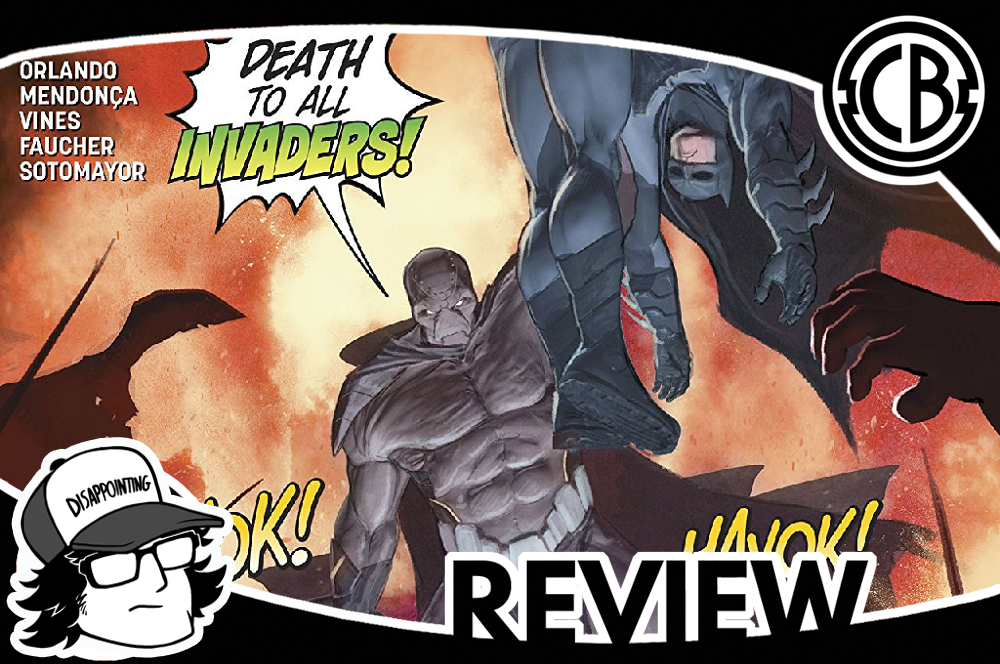Review: Justice League of America #26
By Jonathan Edwards
As it turns out, “New Life and Death” isn’t just the same type of story “Deadly Fable” was. No, as Orlando shows us with Justice League of America #26, “New Life and Death” is also a retread of “Panic in the Microverse.” Except, this time, it ends exactly how I said “Panic in the Multiverse” should have ended in my review of Justice League of America #17, with the villain willingly sacrificing themselves to save their home. The problem is, in the context of “New Life or Death,” that ending makes no sense. Especially since here it doesn’t matter who sacrifices themselves. But, I’m getting a bit ahead of myself.
The previous issue ended with Lord Havok arriving in Angor by somehow forcibly using Dreamslayer as a portal. At the beginning of this one, Havok explains that he “spent years breaking Dreamslayer, implanting subconscious commands.” Meaning, as soon as Dreamslayer arrived in Angor with Batman and Black Canary, his body quietly started the process of bringing Havok there too. Here’s the thing: Dreamslayer has consistently stated that he followed Havok because taking orders and oppressive leadership was all he knew. So, if that’s the case, why would Havok have needed to “break” him at all? What’s more, if Havok was going to spend years slowly brainwashing Dreamslayer, then why wouldn’t he just focus on making Dreamslayer incapable of defecting or being influenced against him? After all, it didn’t take much convincing from Ray for Dreamslayer to turn on Havok. Of course, the questions are all rhetorical because Havok’s explanation is undoubtedly little more than a poorly thought out excuse contrived by Orlando to justify Havok being in Angor for this issue.
Anyway, after some boring fighting, Batman asks the Adjudicator if Angor could live if he sacrificed himself for it. And, yes, as mentioned before, that is apparently enough to both bring back Angor and prevent it from being destroyed a third time. But, how? Batman declares “Angor can’t be recreated by spite or vengeance. The pain that came before can’t be erased… New life requires sacrifice.” And, that Angor “could live anew, but changed. With humility at its core” if he gave his life for it. If that sounds tantamount to gibberish, it’s only because it is. No, seriously, what the fuck is he talking about? Is the implication that Batman’s positive traits would be transferred to all of the inhabitants of Angor, and that’ll make everything better? Then, why does it still work when Havok opts to sacrifice himself instead? Up until now, Havok’s characterization has been nothing but “one-note villain that’s wholly to blame for Angor’s demise.” Last issue started to suggest that the solution would be an Angor without Havok, which ultimately does happen, but that doesn’t explain why Batman sacrificing himself would be a solution as well. Are we meant to believe that the willing self-sacrifice of any individual is enough to offset the massive loss of life from the destruction of an entire planet? Because I’m calling straight bullshit on that.
At least the art is still a relative high point for both this issue and the book overall. I mean, the art of JLA has never been good enough to warrant suffering through the crap story, but there’s a clarity to Miguel Mendonca’s presentation and layouts that’s worth noting. As such, the action all flows very organically and, in general, everything does look good.
Justice League of America #26 ends with a scene between Ryan and Lobo before the latter finally takes off. And, that kind of makes sense. Their relationship may have only been minimally developed throughout this series, but at least there was a little bit of development. So, contextually, it does ultimately work to have them together for Lobo’s departure (even though he’s inevitably going to return to help fight the last big bad). The last page also teases the next and final arc, where the villain Chronos goes after Ray Palmer. Wow, sure glad this book is going out with a story focusing on a supporting character rather than the eponymous team or any of its actual members. Except, I’m actually not.
Score: 2/5
Justice League of America #26
DC Comics


